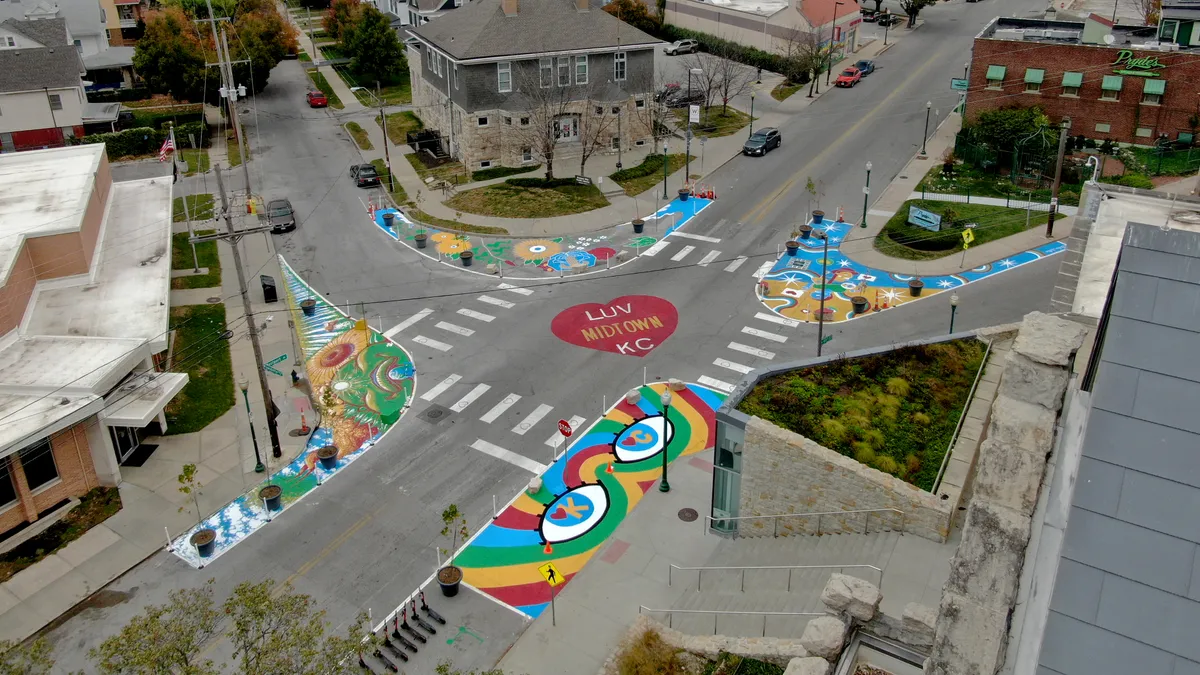Dive Brief:
- As many as 20 cities could each receive up to $25,000 in grant funding under Bloomberg Philanthropies' Asphalt Art Initiative to help local leaders use art and design to improve street safety, revitalize public spaces and engage residents.
- The grant program aims to improve public spaces and support cities to work with artists and community groups on projects involving transportation infrastructure. Officials with Bloomberg Philanthropies said the initiative responds to the growing number of global cities embracing art as a way to make streets, plazas and intersections safer and more welcoming.
- The effort launched in 2019 and has already awarded grants to 16 cities. Kansas City, MO (pictured above); Saginaw, MI; and Norfolk, VA installed their grant-funded projects last fall, with the other awardees across 12 states planning to install their own projects throughout this year.
Dive Insight:
Painted crosswalks and similar design projects have become more widespread in the United States as city leaders look to use art as a way to curb the troubling trend of increasing pedestrian fatalities. Cincinnati, for example, has allowed local groups to paint street murals in a bid to calm traffic for its Vision Zero goals.
The Federal Highway Administration (FHWA), however, issued guidance in 2019 recommending against the use of 3D crosswalks as the agency said it could "result in unsafe behavior by drivers."
There are already signs though that the artwork is having an impact. Kansas City's redesign of one intersection reduced overall vehicle speeds by 45% and shortened pedestrian crossing distances by 50%, according to Bloomberg Philanthropies. The new murals, coupled with safety improvements like curb extensions and boulders, are designed to reduce speed and improve safety for pedestrians.
In addition to the traffic calming effects, leaders said using public art in new ways will be a crucial means to help cities recover from the coronavirus crisis and rebuild a sense of community. Panelists during the Bloomberg CityLab virtual conference — where the initiative was relaunched — called on city leaders to partner with the art community to help shape the future of urban life.
"This is an opportunity to truly rethink, refashion, reshape our cities, our neighborhoods, our towns, our cultural life in a vastly new way," Kamilah Forbes, executive producer at the Apollo Theater in Harlem, NY, said during a panel discussion. "As artists, that’s what we do every time we enter a new project. We take with us what we learned from the last project, but it is about creating amongst a blank slate, and I think city leadership has to take those kinds of bold steps forward, as artists do every day."
The arts have been "particularly hard-hit by the pandemic," said Kate Levin, a principal for cultural assets management at city consulting firm Bloomberg Associates. That sector of city life has been greatly impacted by declining revenues and high unemployment.
But once cities safely reopen, the arts can play a role in helping reunite people who have been apart for so long, according to Forbes. Creativity reminds us of our empathy and humanity, and a recovery must emphasize those aspects of our lives, she said.












